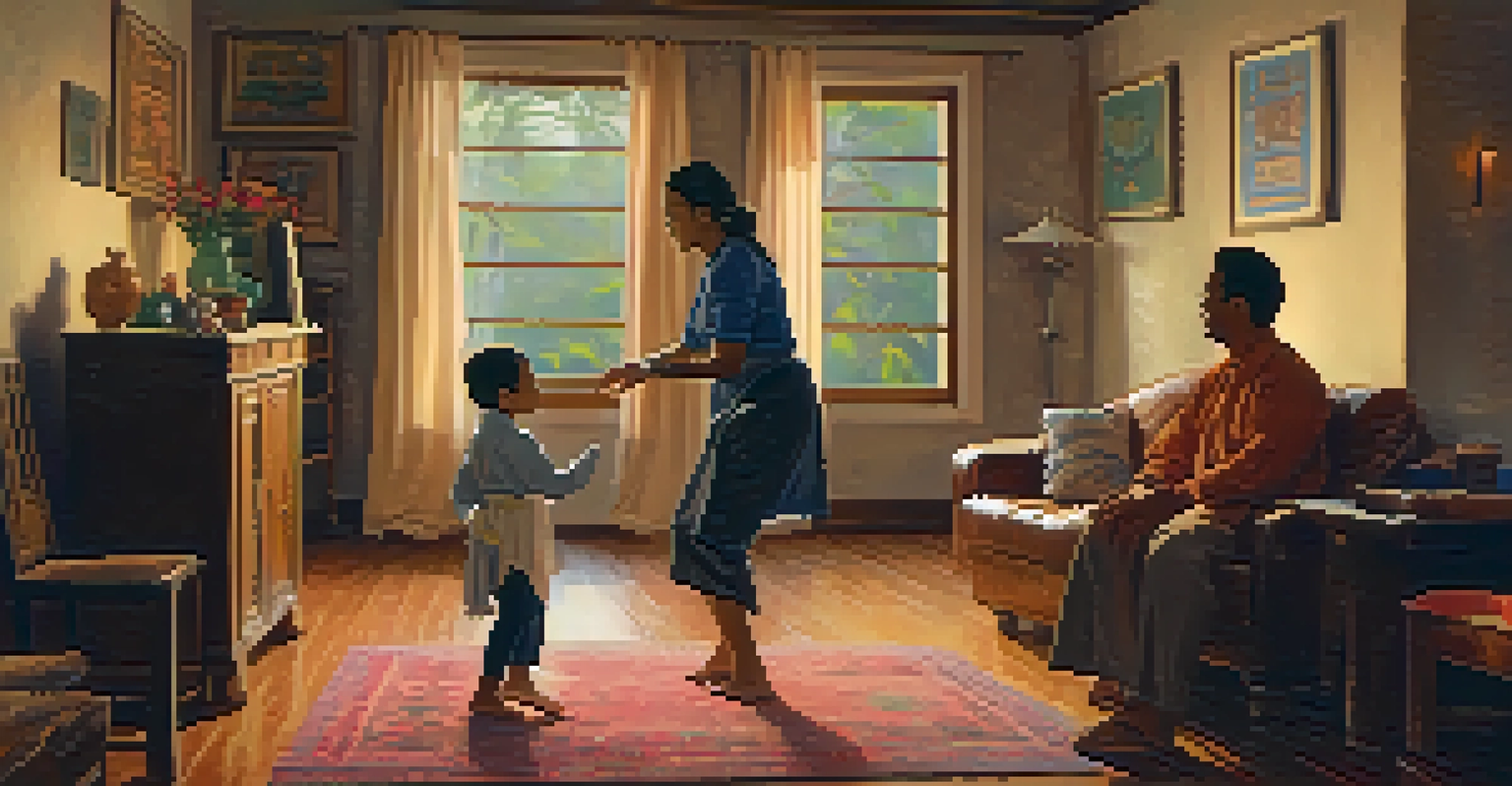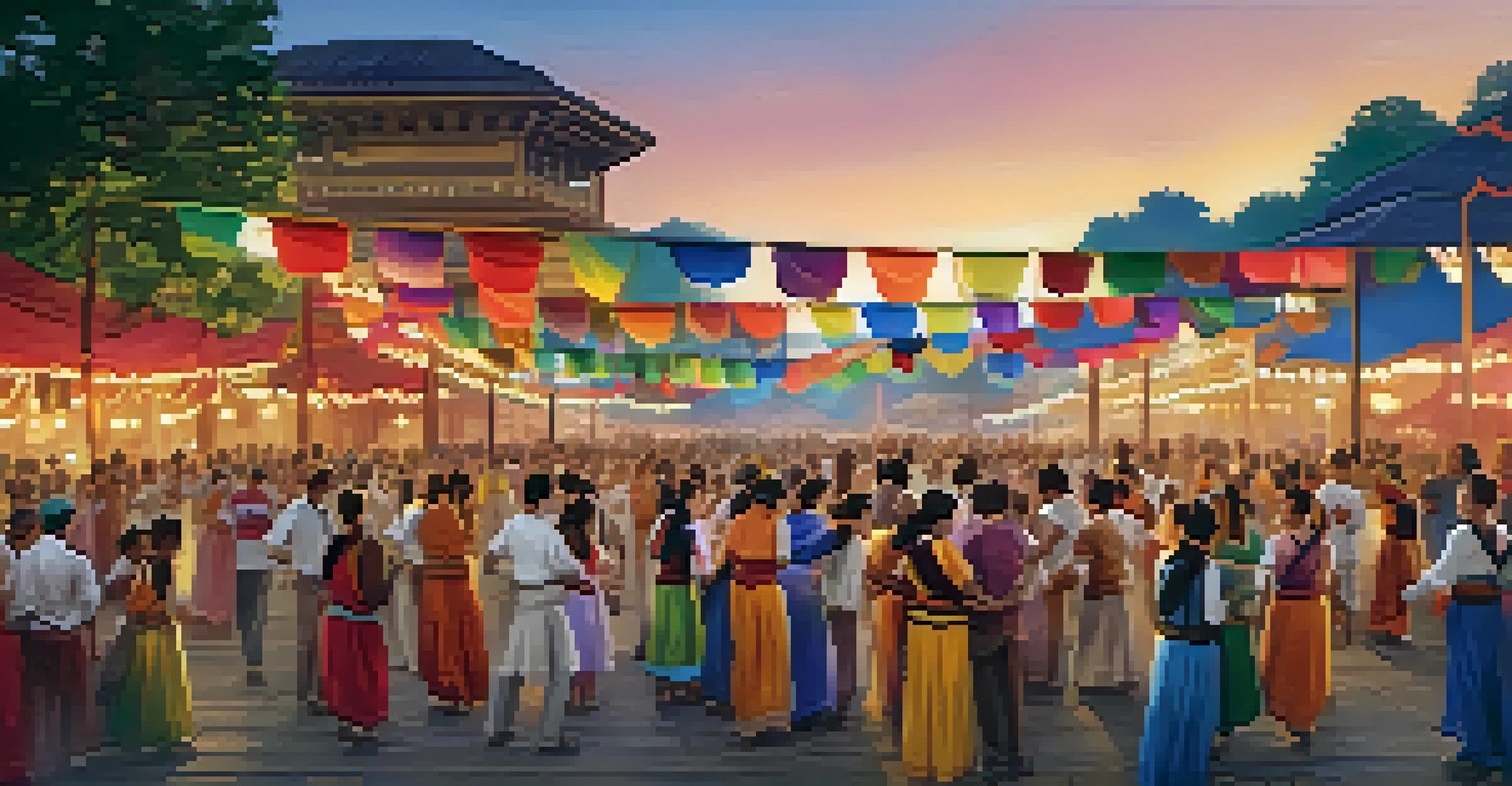Exploring Cultural Dance Traditions in Family Settings

The Importance of Dance in Cultural Heritage
Dance is more than just movement; it's a vibrant expression of cultural identity. Each dance tradition tells a story, reflecting the values, beliefs, and history of a community. For families, engaging with these dances fosters a deeper connection to their heritage, allowing younger generations to understand their roots.
Dance is the hidden language of the soul.
When families participate in traditional dances, they create shared experiences that can be passed down through generations. This not only strengthens familial bonds but also instills a sense of pride in one’s culture. For instance, participating in a family wedding dance can become a cherished memory that reinforces cultural ties.
Moreover, dance often serves as a bridge between the past and present. By learning and performing traditional dances, families can honor their ancestors while adapting these practices to modern life, thus keeping their culture alive and relevant.
Creating Family Traditions through Dance
Establishing family dance traditions can be a joyful way to celebrate cultural heritage. This might involve setting aside time during holidays or family gatherings to teach and learn traditional dances together. Such rituals create a sense of belonging and continuity that can be incredibly meaningful.

For example, consider the annual family reunion where everyone gathers to learn a new folk dance. Not only does this teach the steps, but it also brings laughter and bonding as family members support one another in mastering the moves. These moments become treasured memories that families look forward to.
Dance Strengthens Family Bonds
Engaging in dance as a family creates shared experiences that enhance communication and cooperation among members.
Additionally, incorporating dance into family celebrations, like birthdays or anniversaries, can elevate the occasion. It transforms ordinary events into extraordinary experiences, reinforcing the idea that dance is a vital part of family life.
The Benefits of Dance for Family Connections
Engaging in dance as a family can enhance communication and cooperation among family members. As they learn to dance together, they develop a rhythm not just in their movements but also in their interactions. This collaborative spirit fosters a sense of teamwork and unity.
The dance is a poem of which each movement is a word.
Moreover, dance provides a playful outlet for families to express emotions and creativity. Whether it's joy, sadness, or excitement, movement allows family members to connect on a deeper level. This emotional connection is crucial, especially in today’s fast-paced world where quality time can often be scarce.
Additionally, dance can serve as a stress reliever. Families who dance together often find themselves laughing and enjoying each other's company, which helps to alleviate tension. This shared joy can lead to stronger relationships and a more harmonious family environment.
Cultural Dance as a Teaching Tool
Cultural dance can be a powerful educational tool for families. Through learning the history and significance of various dances, family members can gain insights into different cultures and perspectives. This not only broadens their horizons but also fosters empathy and understanding among diverse communities.
For example, by exploring Native American dance forms, families can learn about the rich traditions and stories behind each movement. This knowledge promotes respect for cultural diversity and encourages conversations about the importance of preserving these traditions.
Cultural Dance Educates Families
Learning about cultural dances broadens family members' perspectives and fosters empathy towards diverse communities.
Furthermore, teaching children about the cultural context of dances can instill respect for their own heritage as well as others. It prepares them to engage thoughtfully with the world around them, creating informed and culturally aware individuals.
Adapting Dance Traditions for Modern Families
While traditional dances hold significant value, modern families can adapt these practices to fit their lifestyles. This could mean incorporating popular music into traditional dance styles or creating new family dances that blend various cultural influences. Such adaptations can make dance more relatable and fun for everyone involved.
For instance, a family might combine hip-hop elements with a traditional folk dance to create a unique performance for a local event. This not only showcases their creativity but also allows them to share their culture in a way that resonates with a broader audience.
Adapting dance traditions encourages families to innovate while respecting their roots, allowing cultural expressions to evolve. This balance between tradition and modernity can keep the family engaged and excited about their cultural heritage.
Dance as a Means of Building Community
Family dance practices can extend beyond the household, helping to build community connections. When families participate in local dance events or festivals, they not only share their culture with others but also forge bonds with neighbors and fellow community members. This collective celebration promotes inclusivity and cultural exchange.
For example, a community festival featuring traditional dances from various cultures can bring families together to learn and celebrate. These gatherings create an atmosphere of unity, where people of all backgrounds come together to appreciate the beauty of diversity.
Modern Adaptations Keep Dance Alive
Adapting traditional dances to modern styles ensures that cultural expressions remain relevant and enjoyable for families.
Additionally, participating in community dance events can inspire families to continue their cultural practices at home. When they see others engaging in similar traditions, it reinforces the value of dance as a tool for connection and celebration.
The Future of Cultural Dance in Families
As society continues to evolve, so too will family dance traditions. The future may see a blending of various styles and influences, leading to new forms of expression that honor the past while embracing the present. Families have the unique opportunity to shape the future of their cultural practices.
Encouraging children to explore different dance forms can lead to innovative practices that reflect their experiences and backgrounds. This not only enriches their understanding of culture but also empowers them to take ownership of their cultural identity.

Ultimately, the continued exploration and celebration of cultural dance within family settings will ensure these traditions remain vibrant and relevant. By engaging with dance today, families can pave the way for future generations to connect with their heritage and each other.